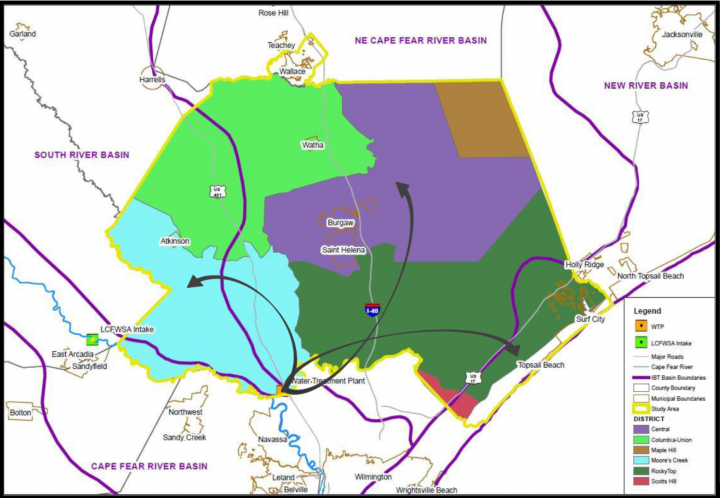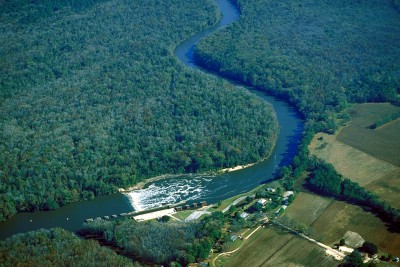
BURGAW – To meet the demands of its ever-growing population, Pender County needs the ability to transfer millions of gallons of water from the Cape Fear River basin, according to county officials.
The county’s petition to the state to shift water from the Cape Fear River to three smaller rivers recently received support from not only county officials, but also environmental groups, whose members applauded the county’s foresight to secure future water needs and protect the area’s water resources.
Supporter Spotlight
“I know Pender County Utilities has been working many years on a very thoughtful, regional approach,” said Bill Holman, North Carolina State Director of The Conservation Fund. “We all know these regional scale systems are more efficient. I commend the approach the county is taking. I think it’s a great step.”

Holman was one of a handful of people to speak at a North Carolina Department of Environmental Quality-sponsored public hearing last week about the county’s petition for what’s called an interbasin transfer, or IBT, certificate.
An interbasin transfer is moving surface water from one river basin into another. Water transferred is not returned to its so-called source basin, which is, in this case, the Cape Fear.
Transfers of 2 million gallons per day or more must, by law, be approved by the state’s Environmental Management Commission.
Pender County is requesting a certificate to transfer up to 14.5 million gallons per day from the Cape Fear River basin to the South River, Northeast Cape Fear River and New River basins.
Supporter Spotlight
The transfer is being requested to meet projected water service demands in the county through 2045.
About six years ago, the county moved from groundwater as its primary source of drinking water to surface water from the river.
Pender County Utilities provides water service to about 7,500 customers in the county’s water and sewer districts as well as the towns of St. Helena and Watha. The utility operates a water treatment plant with a capacity of 2 million gallons per day, where surface water from the Cape Fear River is filtered.
The plant has a capacity to treat up to 6 million gallons per day. The county is also a customer of the Lower Cape Fear Water and Sewer Authority.
The county’s existing water supply will be insufficient to meet the projected water demands through 2045, county officials say.
Booming growth, particularly along the U.S. 17 corridor, has increased the county’s water demand.
Pender’s population growth is projected to jump from 55,900 in 2015 to 118,100 in 2050 in the county’s six water and sewer districts.
“The requested IBT certificate is critical to the county’s ability to meet future demands for water in its service area,” said Pender County Commissioner Jackie Newton.
In addition to meeting future demand, the county is also planning to provide water to residents who depend on groundwater as their drinking water source.

Allie Sheffield, president of the environmental group PenderWatch and Conservancy, stressed her concerns about the shallow wells on which Pender County residents rely for drinking water.
About 78 percent of the county’s population lives along the coastal U.S. 17 corridor in the greater Hampstead area, she said.
“Everybody there’s on wells,” Sheffield said. “Some of the little communities have a well system for the developments. We all realize that the current system is unsustainable and could lead to a catastrophe, honestly.”
Sheffield said she did not fully understand the significance of the dangers of relying on groundwater sources until her organization got involved in a years-long fight to keep a cement manufacturing plant from locating in neighboring New Hanover County.
Titan America planned to pump millions of gallons of water from an area aquifer to mine limestone at its proposed Castle Hayne facility. Titan eventually withdrew its permit application from the state in 2016.
As the sea level rises, there are also concerns about saltwater intrusion in aquifers.
“It’s only getting worse,” Sheffield said. “We live on the coast. We know the tides are getting higher. We know more land is getting covered by water. This is an urgent situation that we need to address and the county is actively addressing it and we appreciate that. When everybody depends on water from an aquifer you just have a lot to worry about as we found out. Our organization’s number one priority is supporting the county in obtaining this certificate. The county is right to plan for a lot of growth.”
Anthony Colon, the public services director of Wallace, which is a co-applicant for the IBT certificate, also urged Steve Keen, the hearing officer at last week’s public hearing and a member of the state Environmental Management Commission, to grant the certificate.
“This is an insurance,” Colon said. “I wish that everybody in the whole state of North Carolina would be doing something like this because this is something that will really help. Towns, counties, we should all be working together.”
North Carolina is divided into 17 major river basins, including the Cape Fear River. Those basins are subdivided into 38 IBT basins.
The Cape Fear River basin is divided into six IBT basins, including the Northeast Cape Fear, South, and New River IBT basins.

DEQ has issued a finding of no significant impact to the Cape Fear River IBT basin, concluding that water elevations above and below Lock and Dam No. 1 and aquatic resources, including water critical to fish that travel from saltwater to fresh water to spawn upstream, are not expected to be directly impacted.
Holman said he agrees with the state’s conclusion that the IBT is best to meet the county’s future water resource needs.
He also emphasized a need to protect river basins, urging collaboration efforts to closely monitor and regulate surface water resources.
He pointed to the ongoing investigation of GenX, a chemical compound that has been released for years from a plant in Fayetteville into the Cape Fear River.
“The county’s really betting its future on the Cape Fear River,” Holman said. “There’s heightened awareness about source water protection in southeastern North Carolina with GenX. Before GenX there were issues about toxic algae blooms in the Cape Fear. There’s always going to be things we’re going to need to be proactive on.”
The commission is expected to make a determination sometime between July and September.







